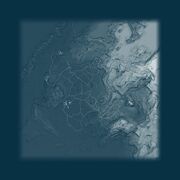
Map of the region.
Angola-Zaire border region was one of the locations Venom Snake visited in 1984. Three major PFs operated in the area, Contract Forces of Africa, Rogue Coyote and Zero Risk Security. In 1984, a civil war was ongoing in the region between UNITA rebels (backed by western powers and South Africa) and the MPLA government (backed by Cuba and the Soviet Union). Ethnic conflict between Mbele and Buta was a part of the civil war, with Mbele siding with the rebels and Buta with the government.[1] The ethnic conflicts in the region ultimately had their root in the 1884 Berlin Conference where both Angola and Zaire, and presumably the rest of the countries in Africa, had borders drawn by the various European colonial powers with little regard for the inhabitants.[2] It also had prevalent acid rain, which was largely the result of the Mfinda Oilfield emitting smoke containing high concentrations of sulfides while burning impurities.[3][4]
Locations[]

- Bwala ya Masa
- Mfinda Oilfield
- Ditadi Abandoned Village
- Nova Braga Airport
- Kiziba Camp
- Bampeve Plantation
- Kungenga Mine
- Lufwa Valley
- Ngumba Industrial Zone
- Munoko Ya Nioka Station
Behind the scenes[]
The area is possibly modeled after part of the Katanga Province in Zaire (now the Democratic Republic of the Congo). The in game map bears a resemblance to the shape of the region, more specifically the upper half. It also borders neighboring Angola and is home to an and a mineral rich which is known to contain uranium ore. It, or at the very least the portion of the region composed of Kiziba Camp, Bwala ya Masa, and Mfinda Oilfield, may have also been located in or near the Ituri rainforest, as Okapi can be found in the area between those three locations, and the Ituri rainforest is their habitat. The Mfinda Oilfield was also implied in Traitor's Caravan to be located near the Munene River.
According to the commentary for concept art (specifically, concept art for Mfinda Oilfield and Bwala ya Masa) included in the Special and GAME editions of the Piggyback Strategy Guide for The Phantom Pain, Hideo Kojima deliberately made some of the locations in the Angola-Zaire border region polluted and gloomy to highlight how foreign (non-African) countries were parasitic on the African resources.[5]
References[]
- ^ ZRS soldier at Lufwa Valley: ...Mbele supporting the rebel forces, and the Bhuta siding with the government. They all look the same to me - skin color, faces, even the language they speak...Even South Africans and Rhodesians have trouble telling them apart, never mind non-Africans.
- ^ Metal Gear Solid V: The Phantom Pain, Kojima Productions (2015)
CFA soldier 1: So... when did they draw up the border around here anyway? // CFA soldier 2: Say what? // CFA soldier 1: Last week, we went off-road and ended up on the wrong side of the border - just like that. // CFA soldier 2: What, do you expect them to put up checkpoints in the middle of nowhere? // CFA soldier 1: But it's not like there are any rivers or mountains to go by. We never even knew when we'd gone across. // CFA soldier 2: Well, it's just a line drawn on a map, that's all. Go back a hundred years, 1884 - European nations come in, divide up the land for colonies, and the lines get drawn. I actually know where they made the final decisions - at a conference in Berlin. So there are some river or mountain borders here and there, but a lot of it's just dawn out with a ruler. // CFA soldier 1: With no thought for the locals, huh? // CFA soldier 2: Right. But the lines have stayed the same ever since. Even if the names and governments of the countries haven't. // CFA soldier 1: Well... I gotta go, man. // CFA soldier 2: Yeah, take it easy. - ^ Metal Gear Solid V: The Phantom Pain, Kojima Productions (2015)
Ocelot (radio): That's some thick smoke. They must be burning the impurities. - ^ Metal Gear Solid V: The Phantom Pain, Kojima Productions (2015)
Ocelot (radio): That smoke is loaded with sulfides. It would certainly explain the acid rain in the region. - ^ Metal Gear Solid V: The Phantom Pain: The Official Guide: Collector's Edition by Piggyback Games, page 401. "Hideo Kojima: 'Some of the locations in Africa are evidently polluted and gloomy. This was a way to highlight how foreign (non-African) countries are parasitic on the resources available in Africa.'"
